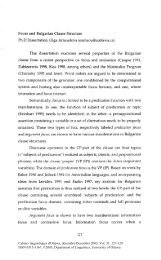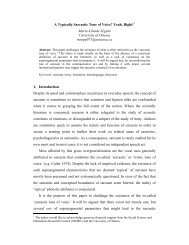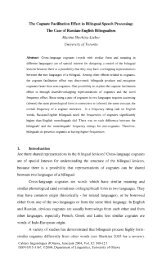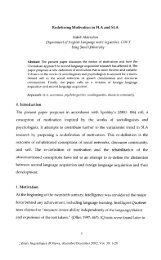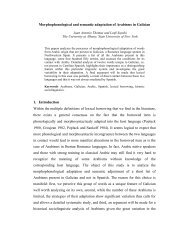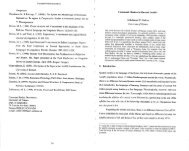Optional wh-movement in French and Egyptian Arabic
Optional wh-movement in French and Egyptian Arabic
Optional wh-movement in French and Egyptian Arabic
You also want an ePaper? Increase the reach of your titles
YUMPU automatically turns print PDFs into web optimized ePapers that Google loves.
<strong>Optional</strong> <strong>wh</strong>-<strong>movement</strong> <strong>in</strong> <strong>French</strong> <strong>and</strong> <strong>Egyptian</strong> <strong>Arabic</strong>Bouihe<strong>in</strong>a LassadiUniversity of OttawaAbstract: In this paper, ] argue that both <strong>French</strong> <strong>and</strong> <strong>Egyptian</strong> <strong>Arabic</strong><strong>in</strong>terrogatives have no <strong>wh</strong>-<strong>movement</strong> <strong>and</strong> favor to leave their <strong>wh</strong>phrases<strong>in</strong>-situ. Whenever these two languages exhibit overt <strong>wh</strong><strong>movement</strong>,1 suggest that it is triggered by some specific features: <strong>in</strong> thecase of <strong>French</strong> <strong>wh</strong>.ere overt <strong>wh</strong>-<strong>movement</strong> is obligatory <strong>in</strong> embeddedquestions, <strong>wh</strong>-rnovement is triggered by the <strong>in</strong>terrogative features ofthe matrix verb. In simple questions, it is triggered by focus features. Inthe case of <strong>Egyptian</strong> <strong>Arabic</strong>, the rare obligatory <strong>wh</strong>-<strong>movement</strong> <strong>and</strong> theoptional <strong>wh</strong>-movernent <strong>in</strong> both simple <strong>and</strong> embedded questions aretriggered by focus features.Keutoords: <strong>wh</strong>-<strong>movement</strong>, optional <strong>movement</strong>, rn<strong>in</strong>imalism, focus, <strong>Egyptian</strong><strong>Arabic</strong>, <strong>French</strong>IntroductionLanguages differ concern<strong>in</strong>g the strategies they apply to form <strong>wh</strong>constructions.In English only one <strong>wh</strong>-phrase is raised <strong>and</strong> the front<strong>in</strong>gstrategy is more frequent than <strong>in</strong> situ strategy, <strong>wh</strong>ich is possible <strong>wh</strong>enwe have a multiple <strong>wh</strong>-word constructions <strong>wh</strong>ere only one <strong>wh</strong>elementmust front leav<strong>in</strong>g the other <strong>in</strong> situ, as <strong>in</strong> (1-3).(1) What did you give to John?(2) "Did you give to John <strong>wh</strong>at?(3) Who did John give <strong>wh</strong>at?In Japanese <strong>and</strong> Ch<strong>in</strong>ese, <strong>wh</strong>-phrases favor the <strong>in</strong>-situ position; as <strong>in</strong>(4):(4) [ohn-wa dare-ni nani-o ageta ka ?Iohn-top <strong>wh</strong>o-dat <strong>wh</strong>at-ace gave Q'Who did John give <strong>wh</strong>at ?'In Bulgarian <strong>and</strong> Serbo-Croatian all <strong>wh</strong>-phrases <strong>in</strong> one sentence areraised; as <strong>in</strong> (5) below(5) Koj kogo vizda?Who <strong>wh</strong>om sees'Who sees <strong>wh</strong>om?'Cahiers l<strong>in</strong>guistiques d'Ottawa, décembre/December 2003, Vol. 31: 67-93ISSN 0315-3167. ©2003, Department of L<strong>in</strong>guistics, University of Ottawa
Bouthe<strong>in</strong>aLassadiIn this paper, I will exam<strong>in</strong>e the behavior of <strong>wh</strong>-<strong>in</strong>terrogatives <strong>in</strong><strong>French</strong> <strong>and</strong> <strong>Egyptian</strong> <strong>Arabic</strong> (henceforth EA), <strong>wh</strong>ich seem to exhibitsimilar patterns for the treatment of <strong>wh</strong>-constructions consist<strong>in</strong>g <strong>in</strong>optionally mov<strong>in</strong>g the <strong>wh</strong>-element. <strong>French</strong> data is taken from theliterature <strong>and</strong> EA data is taken from a collected-corpus based on<strong>Egyptian</strong> speakers.(6) EIle a donne la montre a qui?She gave the watch to <strong>wh</strong>om'to <strong>wh</strong>om did she give the watch ?'(7) A qui a-t-elle donne la montre ?'To <strong>wh</strong>om did she give the watch ?'(8) Seme9t eeh ?Hear.2.S.M.Past What?'What did you hear ?'(9) Leeh amelt kidaWh y do.2S.M.Past that'Why did you do that ?'Examples (6) <strong>and</strong> (7) illustrate how <strong>French</strong> can alternate betweenmov<strong>in</strong>g the <strong>wh</strong>-phrase or leav<strong>in</strong>g it <strong>in</strong>-situ. Examples (8) <strong>and</strong> (9) sho<strong>wh</strong>ow EA uses similar strategies concern<strong>in</strong>g <strong>wh</strong>-phrases. Follow<strong>in</strong>g aclose look at how these two languages treat <strong>wh</strong>-constructions <strong>in</strong> simple<strong>and</strong> complex questions, I focus on the reasons that allow <strong>wh</strong>-words <strong>in</strong><strong>French</strong> <strong>and</strong> EA to stay <strong>in</strong>-situ as <strong>in</strong> <strong>French</strong> 6 <strong>and</strong> EA 8, or optionallyundergo <strong>movement</strong> as <strong>in</strong> <strong>French</strong> 7 <strong>and</strong> EA 9, based on proposals byDenham (2000) <strong>and</strong> _eljko Bo_kovi_ (1998, 2000). I will conclude thatboth <strong>French</strong> <strong>and</strong> EA favor the <strong>in</strong>-situ strategy <strong>and</strong> <strong>wh</strong>en a <strong>wh</strong>-phraseundergoes <strong>movement</strong>, it is related to the existence of a focus featurethat triggers this <strong>movement</strong>. This proposal, as I will expla<strong>in</strong> below, willenable us to analyze <strong>wh</strong>-<strong>in</strong>terrogatives <strong>in</strong> languages such as <strong>French</strong> <strong>and</strong>EA without violat<strong>in</strong>g m<strong>in</strong>imalist pr<strong>in</strong>ciples.In Section 1 of the paper, I discuss how optional <strong>movement</strong> <strong>in</strong><strong>wh</strong>-<strong>in</strong>terrogatives fits the pr<strong>in</strong>ciples of the M<strong>in</strong>imaIist Program. InSection 2, I summarize <strong>and</strong> discuss recent proposals ma<strong>in</strong>ly on <strong>French</strong>on optional <strong>wh</strong>-movernent by Bo_kovi_ (1998, 2000) <strong>and</strong> Denham68
<strong>Optional</strong> <strong>wh</strong>-rnovement <strong>in</strong> <strong>French</strong> <strong>and</strong> Eguptian <strong>Arabic</strong>(2000). In Section 3, I illustrate <strong>and</strong> compare the distribution of <strong>wh</strong>constructions<strong>in</strong> simple questions <strong>and</strong> embedded questions <strong>in</strong> <strong>French</strong><strong>and</strong> EA. In Section 4, I adopt ideas of Denham to account for theoptionality of <strong>wh</strong>-<strong>movement</strong> <strong>in</strong> <strong>French</strong> <strong>and</strong> extend them to <strong>Egyptian</strong><strong>Arabic</strong>. On the one h<strong>and</strong>, I propose to treat these t\VO languages asexclusively <strong>in</strong>-situ languages that do not select C from the lexicon <strong>in</strong>order to trigger <strong>movement</strong> of the <strong>wh</strong>-phrase <strong>in</strong> simple questions. Onthe other h<strong>and</strong>, <strong>wh</strong>enever there is front<strong>in</strong>g of the <strong>wh</strong>-phrase, I<strong>in</strong>terpret it <strong>in</strong> two ways: In the case of <strong>French</strong>, I follow Denham <strong>in</strong>propos<strong>in</strong>g that front<strong>in</strong>g of <strong>wh</strong>-phrases <strong>in</strong> simple questions is triggeredby a focus feature that must be checked before the derivation reachesthe <strong>in</strong>terfaces, <strong>wh</strong>ile front<strong>in</strong>g of <strong>wh</strong>-phrases <strong>in</strong> embedded questions istriggered by the selection of C <strong>in</strong> overt syntax by some <strong>in</strong>terrogativeverbs. In EA front<strong>in</strong>g of <strong>wh</strong>-phrases is uncommon, <strong>wh</strong>ichdist<strong>in</strong>guishes this variety from other varieties of <strong>Arabic</strong>, <strong>and</strong> I proposethat displacement is triggered by focus features <strong>in</strong> both simple <strong>and</strong>embedded questions. In Section 5, I provide a brief conclusion.1. <strong>Optional</strong> Movement <strong>and</strong> the M<strong>in</strong>imalist ProgramWhen analyz<strong>in</strong>g the behavior of <strong>wh</strong>-<strong>in</strong>terrogatives <strong>in</strong> languages suchas <strong>French</strong> <strong>and</strong> <strong>Egyptian</strong> <strong>Arabic</strong>, <strong>wh</strong>ich has not been discussed <strong>in</strong> theliterature, we f<strong>in</strong>d two strategies: one suggests that the <strong>wh</strong>-elementmoves to the front position <strong>and</strong> one favors to leave the <strong>wh</strong>-element<strong>in</strong>-situ as illustrated above <strong>in</strong> (6-9) repeated here <strong>in</strong> (10-13)(10) Elle a donne la montre a qui?She gave the watch to <strong>wh</strong>o'To <strong>wh</strong>om did she give the watch ?'(11) A qui a-t-elle donne la rnontre ?'To <strong>wh</strong>om did she give the watch ?'(12) Seme?t eeh ?Hear.2.S.M.Past What?'What did you hear r(13) Leeh amelt kidaWhy do.2S.M.Past that'Why did you do that ?'69
Bouthe<strong>in</strong>a Lassadi(21) Pierre a dern<strong>and</strong>e qui tu as vu'Pierre asked <strong>wh</strong>o did you see'The ungrammaticality of (20) seems to contradict Bosko v i c ' s<strong>in</strong>terpretation of <strong>wh</strong>-<strong>in</strong>-situ <strong>in</strong> simple questions <strong>wh</strong>ere he proposed to<strong>in</strong>sert C as late as LF. In fact, he expla<strong>in</strong>s that, <strong>in</strong> the case of embeddedquestions, merge cannot occur as late as LF because it does not exp<strong>and</strong>the tree of an embedded sentence. Therefore, merge of C must occur <strong>in</strong>overt syntax <strong>and</strong> this will trigger overt <strong>movement</strong> of the <strong>wh</strong>-word as<strong>in</strong> (21) above. This proposal expla<strong>in</strong>s the ungrammaticality of (20) <strong>and</strong>suggests that overt <strong>wh</strong>-<strong>movement</strong> is the only option available to<strong>in</strong>terpret <strong>wh</strong>-<strong>movement</strong> <strong>in</strong> embedded questions. However, it weakensBoskovic's proposal for simple questions to <strong>in</strong>sert C at LF, s<strong>in</strong>ce it doesnot apply to all types of questions <strong>in</strong> <strong>French</strong>.Although obligatory <strong>in</strong>sertion of C prior to LF <strong>in</strong> the case of<strong>in</strong>direct questions is attributed to <strong>wh</strong>at is claimed to be an <strong>in</strong>dependentrequirement concern<strong>in</strong>g how tree expansion works, a recent proposalby Chomsky still weakens Boskovic's justification on <strong>wh</strong>y C is <strong>in</strong>sertedprior to LF <strong>in</strong> the case of embedded questions. In his attempt to fit head<strong>movement</strong> <strong>in</strong> the bare structure proposal, Chomsky (2000) proposes tohave <strong>wh</strong>at he calls 'local merge' (head-adjunction), <strong>wh</strong>ich does notexp<strong>and</strong> the tree. Indeed, recently, Chomsky proposes to reformulateSpec-Head relations as Head-Head relations, <strong>and</strong> suggests that there <strong>in</strong>there are 111en <strong>in</strong> the garden, may be just a head that is merged, notnecessarily Spec-like. Therefore, if we consider Chomsky's newproposal, it seems that <strong>movement</strong> <strong>and</strong> merge need not necessarilyexp<strong>and</strong> the tree, so Boskovic's justification loses some of its force.In my view, Boskovic's proposal conta<strong>in</strong>s several undesirablecharacteristics. First, that the complementizer C is phonologically nullis not justified us<strong>in</strong>g data from <strong>French</strong>. In fact, Boskovic providessupport for this assumption us<strong>in</strong>g various examples from SerboCroatian (SC) <strong>and</strong> then compares his f<strong>in</strong>d<strong>in</strong>gs from SC data to <strong>French</strong>data. He claims that 'the fact that the complementizer is phonologicallynull is confirmed by data concern<strong>in</strong>g <strong>wh</strong>-constructions <strong>in</strong> SC'(2000: 56).In describ<strong>in</strong>g SC <strong>wh</strong>-data, he claims that I se is a multiple <strong>wh</strong>-front<strong>in</strong>glanguage (that) cannot place more than one fronted <strong>wh</strong>-phrase <strong>in</strong> Spec,74
Bouthe<strong>in</strong>a Lassadiquestions. In addition, I agree with Boeckx's 1999 comments <strong>wh</strong>ensay<strong>in</strong>g that "(Boskovic 's 1998 proposal on <strong>French</strong>) seems to fail tocapture the <strong>in</strong>terpretative differences between (<strong>wh</strong>-phrases <strong>in</strong>-situ <strong>and</strong>fronted <strong>wh</strong>-phrases) (... ) both sentences are assigned roughly the sameLF' (69). In sum, Boskovic's proposal has a number of undesirablefeatures that depart from ideal m<strong>in</strong>imalist pr<strong>in</strong>ciples,Follow<strong>in</strong>g Denham's (2000) proposal on <strong>wh</strong>-<strong>movement</strong> <strong>in</strong>Bab<strong>in</strong>e-Witsuwit'en <strong>and</strong> other languages (See section 2.2. for discussion<strong>and</strong> details), the idea I will defend is that <strong>wh</strong>-<strong>in</strong>-situ <strong>in</strong> languages suchas <strong>French</strong> <strong>and</strong> EA do not have <strong>wh</strong>-<strong>movement</strong>. I will first adoptDenham's proposal on <strong>French</strong> <strong>and</strong> subsequently apply it to EA <strong>in</strong>Section 4 with some modifications needed to account for all of EA's\\7 h-<strong>in</strong>-situ constructions.2.2. Krist<strong>in</strong> Denham (2000)Denham (2000) focuses 'on simple <strong>and</strong> embedded questions <strong>in</strong> order toaccount for the <strong>in</strong>-situ strategy <strong>in</strong> Bab<strong>in</strong>e...Witsuwit'en, an aborig<strong>in</strong>allanguage spoken <strong>in</strong> British Columbia (henceforth BW) <strong>and</strong> thenextends her proposal to show that it applies cross-l<strong>in</strong>guistically tolanguages such as English, <strong>French</strong> <strong>and</strong> Ch<strong>in</strong>ese.Denharn (2000) argues that BW has optional <strong>wh</strong>-<strong>movement</strong>.Front<strong>in</strong>g the <strong>wh</strong>-phrase or leav<strong>in</strong>g it <strong>in</strong>-situ does not lead to mean<strong>in</strong>gchange <strong>in</strong> this language. This means that BW seems to contradict them<strong>in</strong>imalist pr<strong>in</strong>ciple that states that only the most economicalderivation must reach the <strong>in</strong>terface level, s<strong>in</strong>ce front<strong>in</strong>g the <strong>wh</strong>-phraseor leav<strong>in</strong>g it <strong>in</strong>-situ does not make a difference. Denharn solves thiscontradiction by propos<strong>in</strong>g that optionality <strong>in</strong> <strong>wh</strong>-questions arises atthe po<strong>in</strong>t of selection of C from the lexicon; if C is selected, <strong>movement</strong>occurs <strong>and</strong> the <strong>wh</strong>-phrase is fronted. Denham illustrates this proposalthrough examples that show 3 possible positions for an argument <strong>wh</strong>phrase:<strong>in</strong>-situ as <strong>in</strong> (27-28), fronted <strong>in</strong> the embedded clause as <strong>in</strong> (29),or fronted <strong>in</strong> the matrix clause as <strong>in</strong> (30) <strong>in</strong> BW:(27) Lillian ndu yunketLillian <strong>wh</strong>at 3.5. bought 3.5.'What did Lillian bought?'76
<strong>Optional</strong> <strong>wh</strong>-rnovernent <strong>in</strong> <strong>French</strong> <strong>and</strong> Eguptian <strong>Arabic</strong>(28) N d u Lillian yuket ?<strong>wh</strong>at 3.5. Lillian bought 3.5.'What did Lillian bought?'(29) George nditnf book LiIlian yik'iyelhdic yilhni ?George <strong>wh</strong>ich book Lillian 35. read (opt). 3s 3s told. 3s'Which book did George tell Lillian to read ?'(30) Nditni book Geroge Lillian yik'iyelhdic yilhni ?<strong>wh</strong>ich book George LiIlian 3s. read (opt). 3s 3s told. 3s'Which book did George tell Lillian to read ?'She states that optional selection of lexical items followsm<strong>in</strong>imalist pr<strong>in</strong>ciples. She expla<strong>in</strong>s that the lexicon conta<strong>in</strong>s lexicalitems as well as functional items such as C. She also suggests thatoptionality is found <strong>in</strong> the lexicon or more precisely <strong>in</strong> thenumeration. This means that any item, <strong>wh</strong>ether lexical or functional,mayor may not be selected. For Denham, the functional item C caneither be selected or not for any particular derivation (Denham, 2000:207). The selection of C will prompt <strong>wh</strong>-<strong>movement</strong>, the non-selectionof C will leave the <strong>wh</strong>-phrase <strong>in</strong>-situ. As far as overt syntax isconcerned, C is available (i.e. selected from the lexicon) only <strong>wh</strong>en the<strong>in</strong>terrogative features of the matrix verb <strong>in</strong> an embedded questiontrigger such <strong>in</strong>sertion of C otherwise C is not present else<strong>wh</strong>ere <strong>in</strong>overt syntax <strong>and</strong> is not present at all <strong>in</strong> covert syntax (LF).By propos<strong>in</strong>g this hypothesis to account for the optionality of<strong>wh</strong>-<strong>movement</strong> <strong>in</strong> BW, Denham manages not to contradict them<strong>in</strong>imalist pr<strong>in</strong>ciples on economy of derivation. Namely, it is notpossible for two identical sentences to have identical <strong>in</strong>terpretations<strong>and</strong> be both grammatical s<strong>in</strong>ce only one derivation must succeed <strong>in</strong>reach<strong>in</strong>g the <strong>in</strong>terfaces because it is the most economical one.Propos<strong>in</strong>g to optionally select C from the lexicon leads to the creationof two different arrays for a sentence: one conta<strong>in</strong><strong>in</strong>g C <strong>and</strong> the othernot. When compar<strong>in</strong>g both derivations they are both grammaticalbecause they are both the most economical derivations for thatparticular array (Denham, 2000: 208).Therefore, Denham proposes to solve the problem of optional <strong>wh</strong><strong>movement</strong>by allow<strong>in</strong>g optional selection of C from the lexicon. IIf C77
Bouthe<strong>in</strong>a Lassadi<strong>and</strong> its <strong>wh</strong>-feature appears <strong>in</strong> the numeration, it will prompt rais<strong>in</strong>g ofCl <strong>wh</strong>-feature <strong>and</strong> its accompany<strong>in</strong>g <strong>wh</strong>-phrase to check off the <strong>wh</strong>feature<strong>in</strong> C. If C does not appear <strong>in</strong> the numeration, then no <strong>wh</strong><strong>movement</strong>takes place' (Denham, 2000: 287)I see several advantages <strong>in</strong> the above analysis. In evaluat<strong>in</strong>gDenham's proposal, we notice that it succeeds <strong>in</strong> account<strong>in</strong>g for <strong>wh</strong>-<strong>in</strong>situ<strong>in</strong> BW <strong>and</strong> also provides an <strong>in</strong>terest<strong>in</strong>g account to expla<strong>in</strong> the <strong>in</strong>situoption available <strong>in</strong> <strong>French</strong> <strong>in</strong> that it offers to consider focus as ama<strong>in</strong> reason <strong>wh</strong>y <strong>French</strong> simple questions have the option of front<strong>in</strong>gor leav<strong>in</strong>g <strong>in</strong>-situ the <strong>wh</strong>-phrase <strong>and</strong> to expla<strong>in</strong> that overt <strong>wh</strong>-front<strong>in</strong>g<strong>in</strong> embedded guestions is triggered by <strong>in</strong>terrogative features of thematrix verb that leads to <strong>in</strong>sertion of C <strong>in</strong> overt syntax <strong>and</strong> therefore tothe overt <strong>movement</strong> of the <strong>wh</strong>-phrase to C for check<strong>in</strong>g reasons. I willalso provide some evidence (Section 4) that Denham's proposal couldbe exp<strong>and</strong>ed to <strong>wh</strong>-<strong>in</strong>-situ EA data.Denham's proposal does not rely on feature check<strong>in</strong>g <strong>wh</strong>enanalyz<strong>in</strong>g optional <strong>wh</strong>-<strong>movement</strong>. Indeed, this study rejects us<strong>in</strong>gfeature strength as a tool to classify a language as hav<strong>in</strong>g overt <strong>wh</strong><strong>movement</strong>or leav<strong>in</strong>g its <strong>wh</strong>-phrases <strong>in</strong>-situ. This is because featurecheck<strong>in</strong>g has no explanatory value if, with<strong>in</strong> a language, it is possibleto have a strong +<strong>wh</strong> that triggers overt <strong>wh</strong>-<strong>movement</strong> as well as aweak +<strong>wh</strong> that triggers LF <strong>wh</strong>-movernent. Feature strength has alwaysbeen a very disputable element with<strong>in</strong> the various versions ofChomskys work on <strong>wh</strong>-rnovement <strong>and</strong> other issues s<strong>in</strong>ce a clear-cutdef<strong>in</strong>ition of it is still under <strong>in</strong>vestigation. Recently, the strong/weakdichotomy for features has <strong>in</strong> fact been ab<strong>and</strong>oned due to itsproblematic character.Also, Denham's proposal avoids problems with<strong>in</strong> <strong>in</strong>terpretabilityconditions at PF <strong>and</strong> LF <strong>in</strong>terface s<strong>in</strong>ce she does not propose to use thefeatures of the LF <strong>in</strong>terface <strong>in</strong> order to account for covert <strong>movement</strong> of<strong>wh</strong>-phrases <strong>in</strong> the case of <strong>wh</strong>-<strong>in</strong>-situ. Avoid<strong>in</strong>g the LP <strong>in</strong>terface savesDenham's proposal from problems such as late <strong>in</strong>sertion of elementswith <strong>in</strong>terpretable features like +<strong>wh</strong>. Accord<strong>in</strong>g to recent m<strong>in</strong>imalistpr<strong>in</strong>ciples, elements with <strong>in</strong>terpretable features must be <strong>in</strong>serted <strong>in</strong>overt syntax so that they can be <strong>in</strong>terpreted at the <strong>in</strong>terfaces. Delay<strong>in</strong>g<strong>in</strong>sertion of elements could solve the problem of <strong>wh</strong>-phrases <strong>in</strong>-situ by78
<strong>Optional</strong> <strong>wh</strong>-movernent <strong>in</strong> <strong>French</strong> <strong>and</strong> Eguptian <strong>Arabic</strong>suggest<strong>in</strong>g that C has been <strong>in</strong>serted <strong>in</strong> LF but it could also raise seriousproblems deal<strong>in</strong>g with <strong>in</strong>sertion of <strong>in</strong>terpretable elements as late as the<strong>in</strong>terfaces PF <strong>and</strong> LF.As far as <strong>French</strong> is concerned, Denham considers this languageas not exhibit<strong>in</strong>g <strong>wh</strong>-<strong>movement</strong> except <strong>in</strong> embedded questions.<strong>Optional</strong> <strong>wh</strong>-<strong>movement</strong> is apparent <strong>in</strong> simple questions <strong>in</strong> spoken<strong>French</strong>. She considers that the optional front<strong>in</strong>g of the <strong>wh</strong>-phrase <strong>in</strong>simple questions is due to the existence of a focus feature. In embeddedquestions, however, <strong>French</strong> exhibits overt <strong>wh</strong>-<strong>movement</strong> <strong>and</strong> theoption of leav<strong>in</strong>g the <strong>wh</strong>-element <strong>in</strong>-situ is ungrammatical <strong>in</strong> case thematrix verb is an <strong>in</strong>terrogative verb. This restriction enables Denhamto conclude that <strong>wh</strong>-<strong>movement</strong> is apparent <strong>and</strong> is the only optionavailable <strong>in</strong> <strong>French</strong> embedded questions if the matrix verb such asverbs dem<strong>and</strong>er <strong>and</strong> quest ionner has some <strong>in</strong>terrogative features.Accord<strong>in</strong>g to Denham, it is the <strong>in</strong>terrogative feature on the matrix verbthat triggers the selection of C from the lexicon, <strong>wh</strong>ich will also triggerovert <strong>movement</strong> of the <strong>wh</strong>-phrase <strong>in</strong> embedded questions. To sumup/ Denham's analysis of <strong>French</strong> data, the author claims that '<strong>French</strong>does not have overt <strong>wh</strong>..<strong>movement</strong> except <strong>wh</strong>en the properties of theverb require it' (2000:239). As far as <strong>French</strong> simple questions areconcerned, optional front<strong>in</strong>g of a <strong>wh</strong>-phrase is motivated by a focusfeature.Denham's analysis of <strong>French</strong> exhibits various advantages. First,it succeeds <strong>in</strong> provid<strong>in</strong>g an explanation for a wide range of <strong>French</strong> <strong>wh</strong>data(simple questions <strong>and</strong> embedded questions). Second, it avoidsdeal<strong>in</strong>g with problematic issues such as <strong>wh</strong>-feature strength <strong>and</strong> <strong>wh</strong>feature<strong>in</strong>terpretability at the <strong>in</strong>terfaces, <strong>wh</strong>ich weakens the analysis<strong>and</strong> make it more complex without provid<strong>in</strong>g conv<strong>in</strong>c<strong>in</strong>g explanationof <strong>wh</strong>-rnovement. Indeed, she does not claim that the <strong>wh</strong>-feature,<strong>wh</strong>en it is strong triggers <strong>movement</strong> <strong>and</strong> <strong>wh</strong>en it is not strong doesnot. However, she claims that <strong>movement</strong> of the <strong>wh</strong>-phrase is a matterof focus <strong>in</strong> the case of simple questions <strong>and</strong> a matter of <strong>in</strong>terrogativefeature of the verb that triggers the selection of C from the lexicon <strong>in</strong>the case of embedded questions. F<strong>in</strong>ally, Denham's proposal on <strong>French</strong>offers to analyze <strong>movement</strong> <strong>in</strong> <strong>wh</strong>-constructions as focus <strong>movement</strong>.She supports such an analysis with cleft constructions. Indeed, s<strong>in</strong>ce79
Bouthe<strong>in</strong>a LassadiDenham considers that <strong>French</strong> exhibits no <strong>wh</strong>-<strong>movement</strong>, she mustprovide us with a solid argument <strong>in</strong> order to expla<strong>in</strong> <strong>wh</strong>y we can stillobserve overt <strong>movement</strong> of <strong>wh</strong>-phrases <strong>in</strong> <strong>French</strong> data. For thisreason, Denharn proposes that <strong>wh</strong>at triggers overt <strong>wh</strong>-movernent <strong>in</strong><strong>French</strong> is not features of <strong>wh</strong>-<strong>movement</strong> that we f<strong>in</strong>d <strong>in</strong> languages suchas English, but focus <strong>wh</strong>ich imposes overt <strong>movement</strong> on <strong>wh</strong>-phrases.Denham considers <strong>movement</strong> of <strong>wh</strong>-phrases <strong>in</strong> sentences such as (32)below as <strong>wh</strong>-cleft<strong>in</strong>g that must move to C to satisfy a focus feature:(31)Tu as achete quoi?You bought <strong>wh</strong>at'What did you buy?'(32) C' est quoi que tu as achete ?It is <strong>wh</strong>at that you bought'What is it that you bought ?'(33) Qu'est ce que tu as achete ?What did you bought?Sentence (31) represents the option of leav<strong>in</strong>g the <strong>wh</strong>-phrase <strong>in</strong>-situ.Sentence (32) represents <strong>wh</strong>-cleft<strong>in</strong>g <strong>and</strong> sentence (33) represents <strong>wh</strong><strong>movement</strong>to satisfy not a -<strong>wh</strong> feature but to satisfy a focus feature.Accord<strong>in</strong>g to Denham, sentences like (32) constitute evidence for afocus <strong>in</strong>terpretation of <strong>French</strong> <strong>wh</strong>-sentences. Consider<strong>in</strong>g <strong>French</strong> <strong>wh</strong><strong>movement</strong>as triggered by Cl focus feature suggests that <strong>French</strong> exhibitsno <strong>wh</strong>-movernent to check a -<strong>wh</strong> feature.Vergnaud <strong>and</strong> Zubizarreta (2000) also consider that the <strong>in</strong>-situstrategy <strong>in</strong> <strong>French</strong> questions could be l<strong>in</strong>ked to focus. They suggest thatoptional <strong>movement</strong> of <strong>French</strong> questions correlates with hNO types offocus: 'questions with fronted <strong>wh</strong>-phrases are cases of <strong>in</strong>formationalfocus such as <strong>in</strong> A qui est ce que Pierre a parte ? <strong>and</strong> questions with an<strong>in</strong>-situ <strong>wh</strong>-phrase are cases of contrastive focus such as <strong>in</strong> Pierre a parl«a qui?' (see Vergnaud <strong>and</strong> Zubizarreta 2000 for further analysis). Theirproposal suggests that optional <strong>movement</strong> of <strong>French</strong> questions offerstwo dist<strong>in</strong>ct semantic <strong>in</strong>terpretations of a <strong>wh</strong>-question, a hypothesisthat is consistent with m<strong>in</strong>imalist assumptions on optionalderivations.80
<strong>Optional</strong> <strong>wh</strong>-<strong>movement</strong> <strong>in</strong> <strong>French</strong> <strong>and</strong> Eguptian <strong>Arabic</strong>Cedric Boeckx (1999) also criticizes Bo_kovic's approach to<strong>French</strong>, <strong>and</strong> also notes that 'the problematic optionality' that <strong>French</strong>simple questions exhibit should not be accounted for by just posit<strong>in</strong>g acase of <strong>wh</strong>-<strong>movement</strong> with a strong <strong>wh</strong> feature <strong>wh</strong>en there is overtfront<strong>in</strong>g <strong>and</strong> a weak <strong>wh</strong> feature <strong>wh</strong>en there is no overt front<strong>in</strong>g.Instead, develop<strong>in</strong>g a proposal with po<strong>in</strong>ts of contact with my ideas <strong>in</strong>this paper, he considers that <strong>French</strong> questions exhibit focus <strong>in</strong> bothfronted <strong>and</strong> <strong>in</strong>-situ patterns. He also suggests that there are<strong>in</strong>terpretative differences between the two patterns: front<strong>in</strong>g <strong>French</strong>questions correspond to a general <strong>in</strong>formation seek<strong>in</strong>g strategy <strong>and</strong> <strong>in</strong>situ<strong>French</strong> questions correspond to a detail-<strong>in</strong>formation seek<strong>in</strong>gstrategy. As far as <strong>in</strong>terpretative differences are concerned, Boeckxnotices that it is not possible to get the answer 'rien' (noth<strong>in</strong>g) from the<strong>wh</strong>-<strong>in</strong>-situ as <strong>in</strong> (34), neither is it possible to get such answer from acleft question as <strong>in</strong> (35). The answer 'rien' is grammatical with fronted<strong>wh</strong>-phrase as <strong>in</strong> (36): (see Boeckx's 1999 analysis of <strong>French</strong> questions forfurther details).(34) Jean a achete quoi ?Un livreI "rien(35) C' est quoi que Jean a achete ?Un livreI "rien(36)QU' a achete Jean?Un livreI rienThese examples show that <strong>wh</strong>-<strong>in</strong>-situ requires a familiarity of aparticular type with the topic (i.e. participants share background<strong>in</strong>formation before the utterance) however, there is no need forfamiliarity <strong>in</strong> the case of fronted <strong>wh</strong>-phrases as <strong>in</strong> (36).We can now briefly compare Bo_kovic's <strong>and</strong> Denham'sproposals. Insert<strong>in</strong>g C at LF <strong>in</strong> order to account for <strong>wh</strong>-<strong>in</strong>-situ <strong>in</strong> simplequestions <strong>and</strong> <strong>in</strong>sert<strong>in</strong>g C <strong>in</strong> overt syntax to account for fronted <strong>wh</strong>phrases<strong>in</strong> embedded questions as proposed by Bo_kovic does not seemto be an <strong>in</strong>terest<strong>in</strong>g analysis of <strong>French</strong> optional <strong>wh</strong>-<strong>movement</strong>. This isbecause, other than be<strong>in</strong>g unreveal<strong>in</strong>g, this proposal does not fit81
Bouthe<strong>in</strong>a Lassadim<strong>in</strong>imalist pr<strong>in</strong>ciples s<strong>in</strong>ce it must appeal to <strong>in</strong>sertion of elementswith strong features at LF.Denham's proposal, on the other h<strong>and</strong>, seems to offer acomprehensive <strong>in</strong>terpretation of the status of <strong>wh</strong>-<strong>movement</strong> <strong>in</strong>languages such as <strong>French</strong> <strong>and</strong> it can also be used for EA <strong>wh</strong>ere thereseems to be no <strong>wh</strong>-<strong>movement</strong>. In my view, Denhams proposal to treat<strong>wh</strong>-<strong>movement</strong> as l<strong>in</strong>ked to the selection of C from the lexicon fitsm<strong>in</strong>imalist requirements on <strong>wh</strong>-rnovement better that the analysisproposed by Bo_kovic, <strong>and</strong> can be the basis of additional exploration<strong>in</strong>to the semantics of questions of as <strong>in</strong> the work of Boeckx <strong>and</strong>Zubizarreta <strong>and</strong> Vergnaud mentioned above.3. Wh-<strong>movement</strong> <strong>in</strong> <strong>French</strong> <strong>and</strong> EA: simple questions <strong>and</strong> embeddedquestionsAs stated, this study focuses on analyz<strong>in</strong>g <strong>wh</strong>-<strong>movement</strong> <strong>in</strong> questions<strong>in</strong> both <strong>French</strong> <strong>and</strong> EA. In my view, many reasons make thecomparison of these two languages theoretically <strong>in</strong>terest<strong>in</strong>g <strong>in</strong> view ofrecent debates on <strong>wh</strong>-<strong>movement</strong>. First, we saw above that it hasproven controversial <strong>wh</strong>ether <strong>French</strong> is a language that has overt <strong>wh</strong><strong>movement</strong>or a language that tends to keep its w h-phrases <strong>in</strong>-situ. Thisis due to the optionality of mov<strong>in</strong>g or leav<strong>in</strong>g <strong>in</strong>-situ a <strong>wh</strong>-phrase <strong>in</strong>simple questions. However, this optionality of <strong>movement</strong> is notavailable <strong>in</strong> complex questions as it is illustrated <strong>in</strong> the section 3.2.Concern<strong>in</strong>g EA, <strong>wh</strong>-<strong>movement</strong> <strong>in</strong> this language seems to also be very<strong>in</strong>terest<strong>in</strong>g s<strong>in</strong>ce the <strong>in</strong>-situ option is almost always the sole availablegrammatical option. In contrast with other variants, EA is the only<strong>Arabic</strong> dialect that does not front its <strong>wh</strong>-phrases, as most of <strong>Arabic</strong>dialect do front their <strong>wh</strong>-phrases as illustrated by the two sentences <strong>in</strong>(37-38) from St<strong>and</strong>ard <strong>Arabic</strong>. In contrast with EA, the <strong>in</strong>-situ option isusually ungrammatical <strong>in</strong> other varieties:(37) Madha taf?alou?What do3.S.M Pres prog..'What are you do<strong>in</strong>g ?'(38) *Taf?alou madhad03.S.M Pres prog. What'What are you do<strong>in</strong>g ?'82
Bouthe<strong>in</strong>aLassadi(43) Que fais-tu ?'What do you do ?'(44) "Quoi fais-tu ?'What do you do ?'(45) Tu fais quoi ?'What do you do? 'The authors expla<strong>in</strong> that queiquoi alternations is a fact <strong>in</strong> <strong>French</strong>similar to other alterations such as metmoi. In try<strong>in</strong>g to answer thequestion '<strong>wh</strong>y can't quoi appear <strong>in</strong> the Camp position of tense clause ?',the authors expla<strong>in</strong>ed that the alternation que/ouoi suggests that que isan allomorph of quoi <strong>and</strong> that it is also the weak form of quoi. Theauthors analyze que as a clitic <strong>and</strong> provide various arguments tosupport the cliticization properties of que (see Hirschbuhler <strong>and</strong>Bouchard 1987: 43 for details on cliticisation of 'que'). As far as quoi isconcerned, they analyze the impossibility of a bare quoi <strong>in</strong> Camp asl<strong>in</strong>ked to the proposal that quetou oi are <strong>in</strong>complementarydistribution, quoi be<strong>in</strong>g the strong form <strong>and</strong> que be<strong>in</strong>g the allomorphof quoi <strong>and</strong> the weak form. If the strong form, Le. quoi is not justifiedlocally, i.e. <strong>in</strong> the Comp position, the weak form, Le. que must be used.In discuss<strong>in</strong>g the ungrammaticality of front<strong>in</strong>g quoi, Denham(2000) suggests that <strong>wh</strong>-front<strong>in</strong>g is an <strong>in</strong>stance of <strong>wh</strong>-cleft<strong>in</strong>g <strong>and</strong> thatthis front<strong>in</strong>g takes place <strong>in</strong> order to satisfy a strong focus feature (seeDenham's (2000:335-337) discussion on <strong>wh</strong>-cleft<strong>in</strong>g). Hav<strong>in</strong>g said that, itis expected that the location of the basic <strong>wh</strong>-form, <strong>in</strong> this case, the <strong>in</strong>situposition, suggests that <strong>French</strong> <strong>wh</strong>-phrases rema<strong>in</strong> <strong>in</strong>-situ <strong>in</strong> simplequestions <strong>and</strong> that <strong>wh</strong>enever front<strong>in</strong>g is allowed, it must be triggeredby some other features, ma<strong>in</strong>ly focus (this will be further developed <strong>in</strong>section 4).In EA, it seems that <strong>wh</strong>-constructions favor <strong>wh</strong>-phrases torema<strong>in</strong> <strong>in</strong>-situ <strong>in</strong> simple questions as illustrated <strong>in</strong> (46-48) below:(46) Seme?t eeh ?Hear.2.S.M.Past What?'What did you hear ?'84
<strong>Optional</strong> <strong>wh</strong>-<strong>movement</strong><strong>in</strong> <strong>French</strong> <strong>and</strong> Eguptian <strong>Arabic</strong>(47) Guitezzaay?Come.2.S.M.Past How?'How did you come ?'(48) Rayah fi<strong>in</strong> ?Go 2.S.M.Pres. Where ?'Where are you go<strong>in</strong>g ?'It is possible to encounter sentence like (49) below(49) Eeh dah ?What this'What is this'<strong>wh</strong>ere the <strong>wh</strong>-phrase (eeh) '<strong>wh</strong>at' is fronted for a focus <strong>in</strong>terpretation.The same sentence could also be used <strong>in</strong> an exclamation structure<strong>wh</strong>ere the focus is also on the <strong>wh</strong>-phrase [Eeh dah ! mean<strong>in</strong>g, <strong>wh</strong>at'sthat !l.It is rare if not impossible to come across examples <strong>wh</strong>ere the<strong>wh</strong>-word is fronted <strong>in</strong> EA as illustrated <strong>in</strong> (50-52) below(50) "Eeh seme?tWhat Hear.2.S.M.Past'What did you hear ?'?(51) "Ezzaay guit ?How come.2.S.M.Past ?'How did you come ?'(52) *Fi<strong>in</strong> rayah?Where go 2.S.M.Pres.'Where are you go<strong>in</strong>g ?'Judg<strong>in</strong>g from data presented above, EA favors to keep <strong>wh</strong>-phrases <strong>in</strong>situ<strong>in</strong> simple questions. Front<strong>in</strong>g <strong>wh</strong>-phrases is also possible but notdue to check<strong>in</strong>g of +<strong>wh</strong> feature. Front<strong>in</strong>g of <strong>wh</strong>-phrases <strong>in</strong> EA is due tothe existence of a focus feature that triggers <strong>movement</strong> of the <strong>wh</strong>element.In Section 4, I will argue that EA favors to keep <strong>wh</strong>-phrases<strong>in</strong>-situ <strong>and</strong> not front them to get focus because, as a language hav<strong>in</strong>g a85
Bouthe<strong>in</strong>aLassadibasic SVO order, EA tends to move the verb or the verb phrase to getfocus.3.2. Wh-<strong>movement</strong> <strong>in</strong> embedded questionsIn <strong>French</strong> embedded questions, the <strong>wh</strong>-phrase moves up to the head ofthe embedded sentence as <strong>in</strong> (53-56)(53) Pierre a dem<strong>and</strong>e qui tu as vu'Pierre asked <strong>wh</strong>o did you see'(54) Paul voulait savoir pourquoi la parte etait fermee'Paul wanted to know <strong>wh</strong>y the door was closed'(55) Marie se questionnait comment sa mere a pu savoir'Mary asked how her mother could have known'(56) Il dern<strong>and</strong>e qu<strong>and</strong> le film va commencer'He <strong>in</strong>quires <strong>wh</strong>en the movie will start'It is not usually possible to leave the <strong>wh</strong>-phrase <strong>in</strong>-situ <strong>in</strong> embeddedquestions as illustrated <strong>in</strong> (57-60):(57) "Pierre a dern<strong>and</strong>e tu as vu qui(58) "Paul voulait savoir la porte etait fermee pourquoi(59) "Marie se dem<strong>and</strong>ait sa mere a pu savoir comment(60) "Il dem<strong>and</strong>e le film va commencer qu<strong>and</strong>In EA embedded questions, however, the <strong>in</strong>-situ option seems tobe more grammatical than the <strong>wh</strong>-front<strong>in</strong>g option, althoughalternat<strong>in</strong>g with the two options is possible <strong>in</strong> some cases. In examples(61-62) below, we can optionally focus the noun phrase '<strong>in</strong>n at iga'(result) or the <strong>wh</strong>-phrase 'eeh' (<strong>wh</strong>at),(61) Ayiz ye?raf <strong>in</strong>natiga eehWant.3.S.M.Pre. know3.S.I\1.Pres. result <strong>wh</strong>at'He wants to know <strong>wh</strong>at is the result'(62) *Ayiz ye?raf eeh<strong>in</strong>natigaWant.3.S.M.Pre. know3.S.M.Pres. <strong>wh</strong>at result'He wants to know <strong>wh</strong>at is the result'86
<strong>Optional</strong> <strong>wh</strong>-<strong>movement</strong> <strong>in</strong> <strong>French</strong> <strong>and</strong> Eguptian <strong>Arabic</strong>In (61-62) alternat<strong>in</strong>g between focus<strong>in</strong>g the verb phrase <strong>in</strong> theembedded sentence <strong>and</strong> the <strong>wh</strong>-phrase is not possible. It is the verbphrase that must rema<strong>in</strong> focused <strong>in</strong> the embedded sentence s<strong>in</strong>ce EAprefers to focus verbs <strong>and</strong> verb phrases rather than <strong>wh</strong>-phrases. Thisanalysis supports analyses on word order <strong>in</strong> various dialects of <strong>Arabic</strong><strong>wh</strong>ere it has been suggested by many l<strong>in</strong>guists such as (Fassi-Fehri 1993,Plunkett 1993, Koopman <strong>and</strong> Sportiche 1991, Aoun et al 1994,Benmamoun 2000) that <strong>Arabic</strong> dialects have a basic SVO order <strong>and</strong> getthe VSO by mov<strong>in</strong>g the verb to the I position. These authors suggestvarious reasons <strong>wh</strong>y the V moves to I: for tense, topicalization or focus(see Mahfoudhi 2002 for a detailed summary on how these authorsanalyze the front<strong>in</strong>g of V). I consider that <strong>in</strong> EA, <strong>wh</strong>en it comes to fronttwo elements <strong>in</strong> the sentence, a verb phrase or a <strong>wh</strong>-phrase, it is theverb phrase that is focused leav<strong>in</strong>g the <strong>wh</strong>-phrase <strong>in</strong>-situ.(63) Ayiz aa?raf rayah fi<strong>in</strong>want.l.M.Pres. know go.2.S.M <strong>wh</strong>ere'1 want, to know <strong>wh</strong>ere are you go<strong>in</strong>g'(64) "Ayiz aa?raf fi<strong>in</strong> rayahwant.1.M.Pres. know <strong>wh</strong>ere go.2.S.M'I want to know <strong>wh</strong>ere are you go<strong>in</strong>g'However, the option of focus<strong>in</strong>g either the <strong>wh</strong>-phrase oranother element of the sentence (subject or object) is not alwaysavailable as <strong>in</strong> (63-64) below, <strong>wh</strong>ere <strong>in</strong> (64) it is not possible to focus the<strong>wh</strong>-phrase ma<strong>in</strong>ly because the <strong>wh</strong>-phrase <strong>and</strong> the noun phrase refer tothe same entity, <strong>in</strong> this case 'enta' (you). Therefore, front<strong>in</strong>g the nounphrase for focus would be gramnlatical <strong>and</strong> leav<strong>in</strong>g it <strong>in</strong>-situ is not.(65) *Ayiz aa?raf m<strong>in</strong> entawant.l.M.Pres. know <strong>wh</strong>o you'1 want to know <strong>wh</strong>o you are'(66) Ayiz aa?raf enta m<strong>in</strong>want.1.M.Pres. know you <strong>wh</strong>o'I want to know <strong>wh</strong>o are you ?'87
Bouthe<strong>in</strong>aLassadiTo sum up, both <strong>French</strong> <strong>and</strong> EA keep <strong>wh</strong>-phrases <strong>in</strong>-situ <strong>in</strong>various syntactic environments. In <strong>French</strong>, the <strong>in</strong>-situ strategy isfrequently employed <strong>in</strong> simple questions. EA seems to favor the <strong>in</strong>-situstrategy <strong>in</strong> both simple <strong>and</strong> embedded questions.It is the aim of this study to consider <strong>wh</strong>-<strong>movement</strong> <strong>in</strong> <strong>French</strong><strong>and</strong> EA <strong>in</strong> view of the above situation. The facts of <strong>French</strong> <strong>and</strong> EA justreviewed raise the follow<strong>in</strong>g issues, <strong>wh</strong>ich are dealt with <strong>in</strong> thefollow<strong>in</strong>g section: <strong>French</strong> <strong>and</strong> EA do not exhibit <strong>wh</strong>-rnovement.Instead, they favor to keep their <strong>wh</strong>-phrases <strong>in</strong>-situ <strong>and</strong> <strong>wh</strong>en<strong>movement</strong> is observed it is argued that it is triggered by focus. Thisproposal will ma<strong>in</strong>ly solve the problem of optionality of <strong>movement</strong>with<strong>in</strong> a language <strong>and</strong> avoid deal<strong>in</strong>g with the problematic <strong>wh</strong> featurestrength.4. Analyz<strong>in</strong>g <strong>wh</strong>-movernent <strong>in</strong> <strong>French</strong> <strong>and</strong> <strong>Egyptian</strong> <strong>Arabic</strong>Follow<strong>in</strong>g the description about <strong>French</strong> <strong>and</strong> <strong>Egyptian</strong> <strong>Arabic</strong> <strong>wh</strong>questions<strong>in</strong> the previous section, I argue that neither <strong>French</strong> nor EAadopt the <strong>wh</strong>-<strong>movement</strong> strategy <strong>and</strong> favor to leave their <strong>wh</strong>-elernents<strong>in</strong>-situ except <strong>in</strong> some specific syntactic contexts. Even <strong>wh</strong>en <strong>wh</strong><strong>movement</strong>seems to apply <strong>in</strong> these two languages, it is more of a focus<strong>movement</strong> that is occurr<strong>in</strong>g. Indeed, <strong>wh</strong>en look<strong>in</strong>g at both <strong>French</strong> <strong>and</strong>EA <strong>wh</strong>-<strong>movement</strong>, there are examples <strong>wh</strong>ere there is a focus<strong>in</strong>terpretation <strong>in</strong> the case <strong>wh</strong>ere phrases are displaced. This is expla<strong>in</strong>edby data below:(67) Tu as achete quoi ?(68) "Quoi as-tu achete ?(69) Qu'est ce que tu as achete ?In (67), the <strong>wh</strong>-phrase quoi is base-generated <strong>in</strong> the object position <strong>and</strong>mov<strong>in</strong>g it would be ungrammatical as we can see <strong>in</strong> (68). Follow<strong>in</strong>gHirschbuhler <strong>and</strong> Bouchard (1987) analysis of quoi <strong>and</strong> que, <strong>wh</strong>ere theyargued that que is a clitic <strong>and</strong> that quoi is an allomorph of que, I suggestthat (68) above is ungrammatical because of ouoi . Indeed, s<strong>in</strong>ceque/quo; are two allmorphs <strong>in</strong> complementary distribution. Thestrong form tends to be located <strong>in</strong> positions requir<strong>in</strong>g clitic features.88
<strong>Optional</strong> <strong>wh</strong>-<strong>movement</strong><strong>in</strong> <strong>French</strong><strong>and</strong> Eguptian <strong>Arabic</strong>S<strong>in</strong>ce que is considered as the strong form, quoi is excluded from theclitic position.In EA, as demonstrated <strong>in</strong> Sections 2 <strong>and</strong> 3, <strong>wh</strong>-phrases <strong>in</strong>simple questions always rema<strong>in</strong> <strong>in</strong>-situ <strong>and</strong> there are no grammaticalexamples of <strong>wh</strong>-<strong>movement</strong> <strong>in</strong> simple questions. I suggest that thereason for the non-focus use of <strong>wh</strong>-phrases <strong>in</strong> simple questions comesfrom the fact that EA has a basic SVO order that favors the VSO orderby mov<strong>in</strong>g the V to get focus (for a discussion of word order <strong>in</strong> <strong>Arabic</strong>dialects, see Mahfoudhi 2002). S<strong>in</strong>ce <strong>wh</strong>-phrases are related to eithersubject or object <strong>in</strong> <strong>in</strong>terrogative sentences, then focus still rema<strong>in</strong>s onthe verb as we can see from sentences below:(70) Seme?t eeh ?Hear.2.S.M.Past What?'What did you hear r(71) Guit ezzaay?Come.2.S.M.Past How?'How did you come ?'(72) Rayah fi<strong>in</strong> ?Go 2.S.M.Pres. Where ?'Where are you go<strong>in</strong>g ?'As far as embedded questions are concerned, <strong>French</strong> exhibitsovert <strong>wh</strong>-<strong>movement</strong>. I follow Denham's suggestions that <strong>wh</strong>-phraseshave to move <strong>in</strong> embedded questions <strong>wh</strong>enever the matrix verb has<strong>in</strong>terrogative features like dem<strong>and</strong>er, sauoir C is selected by these verbs<strong>and</strong> <strong>wh</strong>-<strong>movement</strong> occurs (see section 2 for Denham's analysis of <strong>wh</strong><strong>movement</strong><strong>in</strong> embedded questions). In EA, I suggest that <strong>wh</strong>-phrasesusually rema<strong>in</strong> <strong>in</strong>-situ <strong>in</strong> embedded questions. EA prefers to focus theverb or verb phrase rather than the <strong>wh</strong>-phrase. Therefore, I concludethat both <strong>French</strong> <strong>and</strong> EA lack <strong>wh</strong>-<strong>movement</strong> that is triggered by astrong +<strong>wh</strong> feature. Both languages favor to leave their <strong>wh</strong>-phrases <strong>in</strong>situbut <strong>wh</strong>enever a <strong>wh</strong>-phrase moves, a focus feature is considered astrigger<strong>in</strong>g such <strong>movement</strong>.As far as focus <strong>movement</strong> is concerned, it provides a naturalaccount of <strong>wh</strong>-rnovement <strong>in</strong>terpretation. Interpret<strong>in</strong>g <strong>wh</strong>-movernent89
Bouthe<strong>in</strong>aLassadi<strong>in</strong> <strong>in</strong>terrogative sentences as focus <strong>movement</strong> has already beenconsidered <strong>in</strong> the literature by many l<strong>in</strong>guists such as Rochemont(1986), Rochemont <strong>and</strong> Cullicover (1990) Boeckx (1999), Vergnaud <strong>and</strong>Zubizaretta (2000) <strong>and</strong> many others. Accord<strong>in</strong>g to Rochemont (1986:177-78), 'Focus is a syntactically represented notion with systematicthough vary<strong>in</strong>g phonological <strong>and</strong> semantic <strong>in</strong>terpretation'. In <strong>French</strong>, aSVO language, <strong>wh</strong>-rnovement occurs for focus reasons <strong>wh</strong>enever wewant to highlight the <strong>in</strong>formation <strong>in</strong> the <strong>wh</strong>-element. In EA, a VSOlanguage, the verb is usually preferably focused leav<strong>in</strong>g <strong>wh</strong>-phrasesfocus as secondary.Further research must be conducted to analyze the syntactic aswell as the semantic <strong>in</strong>terpretative differences that <strong>French</strong> <strong>and</strong> EAquestions exhibit <strong>wh</strong>en <strong>wh</strong>-phrases move or stay <strong>in</strong>-situ ma<strong>in</strong>ly forfocus reasons. This research should exploit Boeckx's 1999 analysis of<strong>French</strong> <strong>and</strong> exp<strong>and</strong> it to EA, a language that exhibits similar featuresconcern<strong>in</strong>g question formation, especially <strong>in</strong> mak<strong>in</strong>g available the <strong>in</strong>situstrategy as <strong>in</strong> <strong>French</strong>. Boeckx departs from a <strong>wh</strong>-feature strengththat expla<strong>in</strong>s <strong>wh</strong> ..front<strong>in</strong>g <strong>in</strong> <strong>French</strong> because this type of explanationdoes not expla<strong>in</strong> <strong>wh</strong>y <strong>wh</strong>-phrases <strong>in</strong> this same language rema<strong>in</strong> <strong>in</strong>-situ.He <strong>in</strong>stead considers that s<strong>in</strong>ce <strong>French</strong> makes available two strategies toform questions there must be two <strong>in</strong>terpretations of questionformations. In fact, he considers that there is <strong>in</strong>terpretative differencesbetween the two strategies: front<strong>in</strong>g <strong>French</strong> questions correspond to ageneral <strong>in</strong>formation seek<strong>in</strong>g strategy <strong>and</strong> <strong>in</strong>-situ <strong>French</strong> questionscorrespond to a detail-<strong>in</strong>formation seek<strong>in</strong>g strategy. He also adds tha t<strong>wh</strong>-<strong>in</strong>-situ questions require a familiarity of a particular type with thetopic (i.e. participants share background <strong>in</strong>formation before theutterance) however, there isno need for familiarity <strong>in</strong> the case offronted <strong>wh</strong>-phrases as described <strong>in</strong> Section 3 above. It is <strong>in</strong>terest<strong>in</strong>g toexplore <strong>in</strong>-depth Boeckx's proposal by apply<strong>in</strong>g it to EA <strong>and</strong> see if itworks to capture the <strong>in</strong>terpretative differences that exists betweenfronted <strong>wh</strong>-questions <strong>and</strong> <strong>in</strong>-situ <strong>wh</strong>-questions <strong>in</strong> EA.5. ConclusionIn this paper, I have argued that both <strong>French</strong> <strong>and</strong> EA have \tvh<strong>movement</strong>only under specific conditions triggered by features of these90
<strong>Optional</strong> <strong>wh</strong>-<strong>movement</strong> <strong>in</strong> <strong>French</strong> <strong>and</strong> Eguptian <strong>Arabic</strong>specific conditions <strong>and</strong> not features of <strong>wh</strong>-rnovement. In the case of<strong>French</strong>, I followed Denham's (2000) proposal. Namely, <strong>French</strong> does not<strong>in</strong>sert C <strong>in</strong> overt syntax <strong>in</strong> simple questions but does that <strong>in</strong> embeddedquestions because specific matrix verbs require this early selection of C,<strong>wh</strong>ich triggers overt <strong>movement</strong> of the <strong>wh</strong>-phrase. I also added that <strong>in</strong><strong>French</strong> overt <strong>wh</strong>-<strong>movement</strong> <strong>in</strong> simple questions is triggered by a focusfeature, jo<strong>in</strong><strong>in</strong>g some recent proposals by Boeckx <strong>and</strong> Zubizaretta <strong>and</strong>Vergnaud, <strong>French</strong> <strong>wh</strong>-phrases <strong>in</strong> simple questions do not require tomove to check out the +<strong>wh</strong> feature on C, <strong>in</strong>stead, they move to checkthe focus feature on Focus position. This <strong>in</strong>terpretation of <strong>wh</strong><strong>movement</strong><strong>in</strong> <strong>French</strong> simple questions has been supported by thebehavior of the <strong>wh</strong>-phrase quoi <strong>wh</strong>ich can only be <strong>in</strong>-situ <strong>and</strong> cannotundergo <strong>movement</strong>. A second argument that supports the <strong>in</strong>-situstrategy <strong>in</strong> <strong>French</strong> questions is l<strong>in</strong>ked to Vergnaud <strong>and</strong> Zubisarreta's2000 analysis of focus <strong>in</strong> <strong>French</strong> questions briefly described <strong>in</strong> Section 3.A third argument that supports the <strong>in</strong>-situ analysis is Boeckx's (1999)analysis of <strong>French</strong> questions presented <strong>in</strong> section 3 above. I have alsoillustrated that <strong>French</strong> data show<strong>in</strong>g the high frequent use of <strong>wh</strong>phrases<strong>in</strong>-situ does suggest that <strong>French</strong> is a language that favors toleave its <strong>wh</strong>-phrases <strong>in</strong>-situ or move them to satisfy a focus feature. Inthe case of <strong>Egyptian</strong> <strong>Arabic</strong>, I proposed that it is also a language thatdoes not exhibit <strong>wh</strong>-<strong>movement</strong> <strong>and</strong> that any <strong>in</strong>stance of overt <strong>wh</strong><strong>movement</strong>is triggered by a focus feature that must be checked byfront<strong>in</strong>g the <strong>wh</strong>-elernent to the Focus position. Future research, basedon Boeckx's (1999) proposal will enable us to capture the <strong>in</strong>terpretativedifferences between fronted <strong>wh</strong>-phrases <strong>and</strong> <strong>wh</strong>-<strong>in</strong> situ <strong>and</strong> will enableus to better analyze the importance of focus as the ma<strong>in</strong> explanation to<strong>wh</strong>-movernent <strong>in</strong> languages such as <strong>French</strong> <strong>and</strong> EA. Further researchis also needed to explore the different types of foci as presented byVergnaud <strong>and</strong> Zubizaretta 2000 (briefly discussed <strong>in</strong> Section 3 above) tosee <strong>wh</strong>ich type of focus is compatible with <strong>wh</strong>ich question form, thefronted or the <strong>in</strong>-situ.91
Bouthe<strong>in</strong>a LassadiReferencesAoun, [oseph <strong>and</strong> Li, Audrey. "Wh-elements <strong>in</strong>-situ: Syntax or LF ?"L<strong>in</strong>guistic Inquiry 24 (1993) : 199- 238.Boeckx, Cedric. "Decompos<strong>in</strong>g <strong>French</strong> Questions". University ofPennsylvaniaWork<strong>in</strong>g Papers <strong>in</strong> L<strong>in</strong>guistics 6.1 (1999) : 69-80.Boskovic, Zeljko. "Wh-<strong>movement</strong> <strong>and</strong> <strong>wh</strong>-phrases <strong>in</strong> Slavic" Positionpaper presented at the Comparative Slavic MorphosyntaxWorkshop, Spencer, Ind. June 1998.__"Sometimes <strong>in</strong> [Spec, CP], Sometimes <strong>in</strong> situ". Step by Step:Essays011 Ivi<strong>in</strong><strong>in</strong>tatist Syntax <strong>in</strong> Honor of Houiard Lasnik. Edited byRoger Mart<strong>in</strong>, David Michaeks, <strong>and</strong> Juan Uriagereka. Cambridge:MlT Press, 2000.__"On Multiple Wh-Front<strong>in</strong>g" L<strong>in</strong>guistic Inquiry_33 (2002) : 351-383.Cheng, Lisa. On the typology of ioh-questions. New York: Garl<strong>and</strong>Publications, 1997.Cheng, L. <strong>and</strong> Rooryck, J. "Licens<strong>in</strong>g <strong>wh</strong>-<strong>in</strong>-situ" Syntax_3 (2000) : 1-19.Chomsky, Noam. "On Wh-<strong>movement</strong>". Formal Syntax. Edited by PeterCullicover, Thomas Wasow <strong>and</strong> Adrian Akmajian. NY: AcademicPress, 1977.__"Bare Phrase Structure". Government <strong>and</strong> B<strong>in</strong>d<strong>in</strong>g Theory <strong>and</strong> theM<strong>in</strong>imalist Program. Edited by Gert Webelhuth. Cambridge:Blackwell, 1995.__ The M<strong>in</strong>imalist Program. Cambridge: MlT Press, 1995.__"M<strong>in</strong>irnalist Inquiries: The Framework". Step by Step: Essays i11Honor of Hotoard Lasnik. Edited by Roger Mart<strong>in</strong>, David Michaels,<strong>and</strong> [uana Uriagereka. Cambridge: MIT Press, 2000.__"Derivation by Phase", MIT Work<strong>in</strong>g papers.Cole, Peter <strong>and</strong> Herrnan, G. "Is there LF Wh-Movement ?". L<strong>in</strong>guisticInquiry 25 (1994) : 239-262.Denharn, Krist<strong>in</strong>. "<strong>Optional</strong> Wh-<strong>movement</strong> <strong>in</strong> Bab<strong>in</strong>e-Witsuwitten".Natural Language <strong>and</strong> L<strong>in</strong>guistic Theory 18 (2000) : 199-~51.Epste<strong>in</strong>, S. et al. "Introduction". M<strong>in</strong>imal Ideas. Edited by Abraham, W.et al. Amsterdam: John Benjam<strong>in</strong>s, 1996.Fehri-Fassi, A. L<strong>in</strong>guistique Arabe: [ormes et <strong>in</strong>terpretation. Rabat:Publications de la Faculte des Lettres et Sciences Huma<strong>in</strong>es, 1982.92
<strong>Optional</strong> <strong>wh</strong>-<strong>movement</strong> <strong>in</strong> <strong>French</strong> <strong>and</strong> Eguptian <strong>Arabic</strong>Hirschbuhler, P. "The <strong>French</strong> <strong>in</strong>terrogative pronoun que". L<strong>in</strong>guisticSy'nposiu111 011 R0111ance Languages 9. Edited by W.W. Cressey<strong>and</strong> D.J. Napoli. NY: Georgetown University Press, 1979.Hirschbuhler. P. <strong>and</strong> Bouchard, D. "<strong>French</strong> Quoi <strong>and</strong> its CliticAllomorph Que". Studies <strong>in</strong> Romance Languages. Edited by CarolNeidle <strong>and</strong> Rafael A. NunezPublications, 1987.Cedefio. Dordretcht: ForisMahfoudhi, Abdessatar. 11 Agreement Lost, Agreement Rega<strong>in</strong>ed. AM<strong>in</strong>imalist Account of Word Order <strong>and</strong> Agreement Variation <strong>in</strong><strong>Arabic</strong>". California L<strong>in</strong>guistic Notes 27(2), 2002.Marantz, Alec. "The M<strong>in</strong>imalist Program". Government <strong>and</strong> B<strong>in</strong>d<strong>in</strong>gTheory <strong>and</strong> the M<strong>in</strong>imalist Program. Edited by Gert Webelhuth.Cambridge: Blackwell, 1995.Pesetsky, David. "Wh-<strong>in</strong>-situ: <strong>movement</strong> <strong>and</strong> unselective b<strong>in</strong>d<strong>in</strong>g".The Representation of (In)def<strong>in</strong>iteness. Edited by E.J. Reul<strong>and</strong> <strong>and</strong>ATer Meulen. Cambridge: MIT Press, 1993.Rochemont, Michael S. Focus <strong>in</strong> Generative Grammar. Amsterdam:John Benjam<strong>in</strong>s Publish<strong>in</strong>g Company, 1986.Rochemont, M.S. <strong>and</strong> Peter, Culicover. English Focus Constructions<strong>and</strong> the Theory of Grammar, Amsterdam: John Benjam<strong>in</strong>sPublish<strong>in</strong>g Company, 1990.Stroik, Thomas. "English Wh-<strong>in</strong>-situ Constructions" L<strong>in</strong>guisticAnalysis 22 (1992) :133-153.__ M<strong>in</strong>im alism, Scope, <strong>and</strong> VP Structure, London: SAGEPublications, 1996.Vergnaud ].R. <strong>and</strong> M.L. Zubizar et ta. "The Logical Structure ofInformational <strong>and</strong> Contrastive Focus". Manuscript (Abstract),University of Southern California} 2000.Youhanna, Ellaty. "Le doma<strong>in</strong>e C en Arabe". Manuscript, University ofDamascus, 2001.Bou the<strong>in</strong>a LassadiDepartment of L<strong>in</strong>guisticsUniversity of Ottawae-mait: blass074@uotfa'lva.ca93



